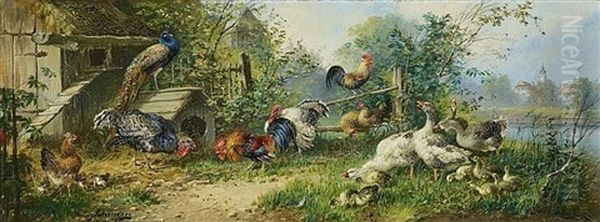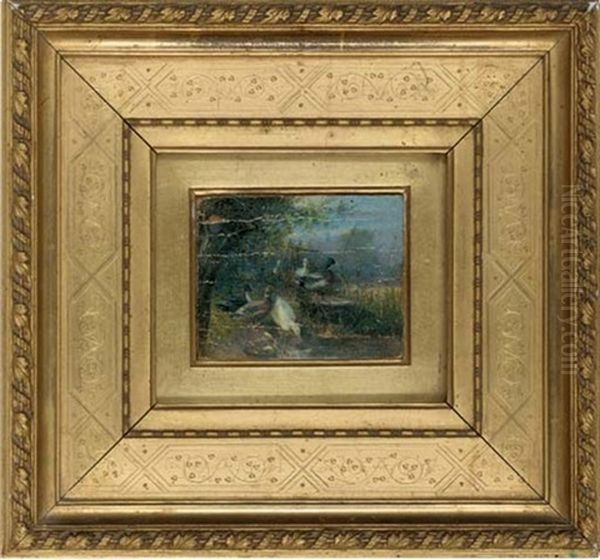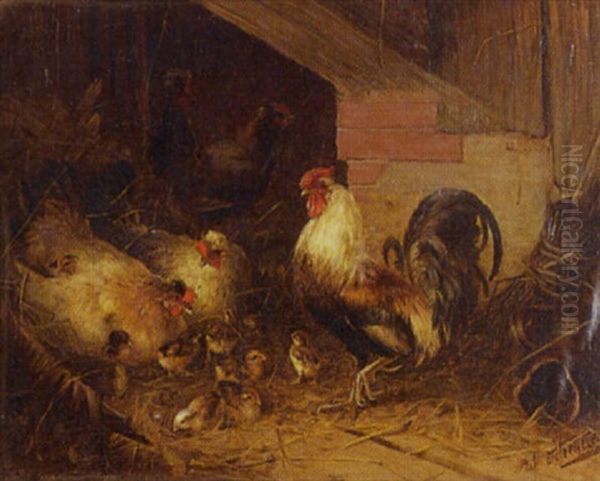Julius Scheuerer stands as a notable figure in German art history, particularly recognized for his dedication to animal painting during the late 19th and early 20th centuries. Born in 1859 and passing away in 1913, Scheuerer carved a specific niche for himself, focusing primarily on the depiction of domestic life, especially the feathered inhabitants of the farmyard. His nationality was German, and his artistic contributions offer a window into the rural aesthetics and the specific genre of animal painting popular during his time.
Scheuerer's work is characterized by a commitment to realism and a keen eye for the nuances of animal behaviour and appearance. He moved within an artistic period marked by significant shifts, including the lingering influence of Realism and Naturalism, the advent of Impressionism, and the rise of Jugendstil (German Art Nouveau), though his own style remained largely grounded in detailed, objective representation.
The Artist's Focus: Farmyard Fauna
The core of Julius Scheuerer's oeuvre revolves around the depiction of farm animals, with a particular emphasis on poultry. Chickens, ducks, geese, and turkeys were frequent subjects, often portrayed within their naturalistic environments – the barnyard, the coop, or grassy fields. He possessed a remarkable ability to capture the textures of feathers, the specific postures of birds, and the interplay of light on their forms.
His paintings often present these creatures not merely as static subjects, but as active participants in their world. Scenes might depict chickens scratching in the dirt, ducks preening by a pond, or a proud rooster surveying his domain. This focus on everyday rural life resonated with audiences who appreciated idyllic yet truthful representations of the natural world, a common theme in German art of the period.
Scheuerer worked predominantly in oils, a medium that allowed him to achieve the rich detail and vibrant colours seen in his depictions of plumage and surroundings. His compositions are typically well-balanced, drawing the viewer's eye towards the animal subjects while still providing a sense of their environment.
Representative Works: Capturing Animal Life

Among Julius Scheuerer's well-known works, titles like Geflügelhof (often translated as Poultry Yard or Chicken Yard) exemplify his primary subject matter. These paintings showcase his skill in rendering multiple birds within a single scene, capturing the dynamic energy of a bustling farmyard environment. Each bird is often given individual attention, highlighting variations in breed and posture.
Another significant piece mentioned is Peacock, dated 1907. This work is particularly interesting as it portrays the peacock in a landscape seemingly devoid of human intervention, allowing the bird's natural majesty and untamed beauty to dominate the scene. It underscores Scheuerer's interest not just in domestic animals but also in capturing the inherent character and presence of the creatures he painted, presented within a realistic, natural setting.
These works demonstrate Scheuerer's consistent style: a realistic approach combined with careful observation. He aimed to portray the animals authentically, capturing their essence without excessive sentimentality, yet often imbuing the scenes with a sense of pastoral calm and order.
Artistic Milieu: Germany at the Turn of the Century
Julius Scheuerer was active during a vibrant and transformative period in German art. The late 19th century saw the consolidation of the German Empire and a flourishing of arts and culture. Munich, in particular, became a major centre for art education and practice, especially renowned for its Academy and its strong tradition in landscape and animal painting. While Scheuerer's specific training details are not provided in the source material, artists specializing in animal subjects often gravitated towards Munich.
The era was dominated by various artistic currents. Realism and Naturalism, which emphasized faithful depiction of the observable world, continued to be influential. Simultaneously, Impressionism was making inroads, although its impact on German art was perhaps less pervasive initially than in France. Towards the end of the century, Jugendstil emerged, championing decorative forms, organic lines, and a synthesis of art and craft.
Scheuerer's work aligns most closely with the Realist tradition, particularly within the specialized field of animal painting (Tiermalerei). While he operated during the peak of Jugendstil, his style does not typically embrace its characteristic stylization or overtly decorative qualities. However, the period's general appreciation for nature and organic forms might have subtly informed the context in which his detailed animal studies were received.
Contemporaries in the Art World
Julius Scheuerer worked alongside a diverse array of artists, both within Germany and across Europe. Understanding his contemporaries helps place his specific contributions in context.

One figure sometimes mentioned in proximity, though distinct in style and nationality, is Karl Scheurer (note the different spelling). Karl Scheurer was a Swiss artist associated with the Jugendstil movement, known primarily for his graphic work, including posters and illustrations. His style was markedly different from Julius Scheuerer's realism, focusing on decorative lines and stylized forms typical of Art Nouveau.
Within the realm of German animal and landscape painting, several contemporaries were prominent. Otto Scheuerer, likely a relative (though the exact relationship requires further verification beyond the provided text), was also known as a German animal painter, suggesting a possible family tradition in the genre.
Heinz Hoppe, another German painter, focused on landscapes and animals. Sources suggest he worked within the tradition established by both Otto and Julius Scheuerer, indicating a direct line of influence or stylistic affinity, particularly in the specialized field of animal depiction.
Heinrich von Zügel (1850-1941) was a highly influential German animal painter associated with the Munich School. He was particularly known for his depictions of cattle and sheep, often incorporating Impressionistic techniques to capture light and atmosphere, representing a more modern approach compared to Scheuerer's detailed realism.
Anton Braith (1836-1906), also a key figure of the Munich School, specialized in painting cattle and sheep, often in Alpine settings. His work, alongside Friedrich Voltz, represents the earlier generation of Munich animal painters whose realism influenced many successors.
Friedrich Voltz (1817-1886) was an important predecessor in the Munich animal painting tradition, known for his pastoral landscapes often featuring cattle, influencing artists like Braith and Zügel.
Expanding the scope of animal painters, Wilhelm Kuhnert (1865-1926) gained fame for his dramatic paintings of African wildlife, bringing an exotic element to German animal painting and achieving significant international recognition.
Richard Friese (1854-1918) was another German painter celebrated for his depictions of European wildlife, particularly deer and other large game animals, often shown in dramatic natural landscapes.
Focusing again on domestic animals, Alexander Koester (1864-1932) became famous almost exclusively for his paintings of ducks, rendered with an Impressionistic flair that captured the play of light on water and feathers. He was a direct contemporary whose specialization, though different, parallels Scheuerer's focus.
Carl Jutz the Elder (1838-1916) was a German painter from Düsseldorf, renowned for his highly detailed and polished paintings of poultry, particularly chickens and ducks, in idyllic settings. His work shares a thematic similarity with Scheuerer's focus.

Landscape painters often incorporated animals, blurring genre lines. Philipp Röth (1841-1921) was known for his atmospheric landscapes, sometimes featuring animals, and was associated with the artists' colonies like Kronberg.
Ludwig Dill (1848-1940), a prominent landscape painter and co-founder of the Dachau artists' colony near Munich, also worked during this period, contributing to the strong tradition of landscape art in Southern Germany.
Even leading figures of German Impressionism, like Max Liebermann (1847-1935), occasionally depicted rural scenes and animals, although their primary focus and stylistic approach differed significantly from Scheuerer's dedicated animal realism. Similarly, Lovis Corinth (1858-1925), known for his transition from Realism to Expressionism, was another major figure active during Scheuerer's lifetime.
Finally, Stefan Jäger (1877-1962), an Austro-Hungarian painter who later settled in Hatzfeld, Germany, worked across various genres including landscape and potentially animal subjects, representing the broader artistic activity in the region during the early 20th century. While the provided sources do not confirm direct contact between Jäger and Scheuerer, they were contemporaries active within Germany.
Scheuerer's Artistic Legacy
Julius Scheuerer's contribution to German art lies in his dedicated and skillful portrayal of a specific, perhaps humble, subject matter: the animals of the farmyard. He excelled in the realistic rendering of poultry, capturing their forms, textures, and behaviours with meticulous care. His work offers a valuable record of this particular niche within the broader genre of animal painting (Tiermalerei), which held significant popularity in 19th and early 20th-century Germany.
While perhaps not an innovator on the scale of the Impressionists or Jugendstil leaders, Scheuerer represented a solid continuation of the Realist tradition in animal depiction. His paintings were appreciated for their technical skill, observational accuracy, and the quiet charm of their rural subjects. They found a ready market among those who valued representations of nature and pastoral life.
Today, Julius Scheuerer's works appear in auctions and private collections, appreciated by enthusiasts of traditional animal painting. He remains a recognized name within his specific field, remembered for his consistent focus and the quality of his execution. His paintings serve as fine examples of German animal art from the turn of the century, capturing a specific facet of the natural world with dedication and artistry.
Conclusion
Julius Scheuerer (1859-1913) was a German artist who specialized in animal painting, with a distinct focus on poultry and farmyard scenes. Working primarily in oil, he employed a realistic style characterized by detailed observation and skillful rendering of his subjects and their environments. His notable works, such as Geflügelhof and Peacock, showcase his ability to capture the natural behaviour and appearance of animals. Active during a period of significant artistic change in Germany, Scheuerer maintained his commitment to realism within the popular genre of Tiermalerei. He worked contemporaneously with numerous other artists, including specialists in animal and landscape painting associated with major art centres like Munich, contributing his unique focus on domestic fauna to the rich tapestry of German art at the turn of the 20th century. His legacy endures through his finely crafted depictions of rural life.